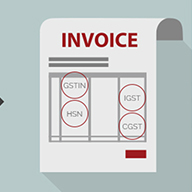GST Fundamentals: Doing the invoices right

GST
411 week ago — 6 min read
GST requires an SME to be on top of it’s paperwork from day one. When it comes to book-keeping and of course, especially when it comes to invoices. This article will give clarity on what is required on an invoice and what the invoice matching concept actually means.
GST Invoice
The GST Act has specified different types of invoices like tax invoice, bill of supply, debit/credit note, receipt voucher etc. to be prepared as per the nature of the transaction. Through our this article, we singularly aim to acquaint you with the essence of the invoices to be issued under the ambitious tax regime.
First things first, invoice is a basic document for recording the sale/purchase in the books of account. All GST taxpayers are free to design their own invoice format, law only requires that certain fields must mandatorily be on the invoice such as:
- Invoice number and date
- Customer name
- Shipping and billing address
- Customer and taxpayer’s GSTIN
- Place of supply
- HSN code
- Taxable value and discounts
- Rate and amount of taxes i.e. CGST/ SGST/ IGST
- Whether tax is payable on reverse charge basis
- Item details i.e. description, unit price, quantity
- Signature or digital signature of the supplier or his authorised representative.
Types of invoice
Tax invoice: When a registered taxable person supplies taxable goods or services, a tax invoice is issued. CBEC on its official website has mentioned certain particulars that must be disclosed in a tax invoice. Some of the special points to be noted in the case of a tax invoice are as follows:
1. Every registered taxpayer has to issue an invoice at any time before the delivery of goods and/or within 30 days/ 45 days* from the date of supply of services.
2. Small dealers doing a large number of transactions for up to a value of Rs. 200 per transaction to unregistered customers need not issue the invoice for every such transaction, instead, they can issue one consolidated invoice at the end of each day for all the transactions done during the day.
3. The taxpayer shall prepare three copies of invoice: one for the buyer, second for the transporter and third for self. Similarly, person rendering services shall prepare the invoice in duplicate: one for service receiver and second for self.
4. Alternatively, a supplier may generate an invoice reference number from the GSTN portal and provide the same to the transporter. In such a case, his goods need not be accompanied by paper invoice during transportation.
5. In case of a reverse charge, the recipient is under no obligation to issue a tax invoice instead the supplier shall mention in the invoice that reverse charge is applicable.
*45 days in case of a supplier being an insurer, a banking company or a financial institution, including a non-banking financial company.
- Bill of supply: Under GST there are some instances where the supplier is not permitted to charge any tax. Therefore, a Tax Invoice can’t be issued and alternatively, another document called Bill of Supply is issued. For example, a registered supplier may issue bill of supply when exempted goods or services are supplied or when supplier is paying tax under the composition scheme; bill of supply may also be issued by unregistered persons who are not required to pay GST.
- Credit note/ Debit note: A taxpayer cannot make changes in a tax invoice after it is uploaded on GSTN. Any revision, modifications, settlement of taxable value or tax charged will be carried out through credit notes and debit notes.
Time limit:
a) Credit note needs to be issued not later than September month of the succeeding year in which supply was aggravated or date of filing annual return, whichever is earlier.
b)There is no time limit for the issuance of debit note but since credit is not eligible after a specified time, debit note should be issued approximately within the same time frame as of a credit note. Examples: A credit note may be issued by the supplier when the taxable value/tax charged in the original invoice exceeds actual taxable value/actual tax to be paid. Similarly, a debit note may be issued by the supplier when the taxable value/tax charged in the original invoice is less than the actual taxable value/actual tax to be paid.
- Receipt voucher: It shall be issued in case of advance receipt for supply of goods and services. GST paid at the time of issuance of receipt voucher shall be adjusted while raising of tax invoice. Receipt voucher, not being a tax invoice, will not be considered as an eligible document for availing of credit in the hands of the recipient.
Invoice matching concept
Invoice matching is a mechanism under which all the taxable supplies made under GST will be matched against all the taxable supplies received by the buyer. Every purchase for ‘x’ must be a sale for someone ‘y’. This invoice matching is possible only when both the buyer and the supplier are tightly integrated through an information system. Thus, if ‘x’ claims an invoice from ‘y’, the system will automatically check the sales of “y” to verify and input tax credit will be available only if ‘y’ pays the tax. The system thus eliminates any possibility of generating credit without paying the tax.
Therefore the taxpayers should take utmost care while raising invoices as the same information will be uploaded in the returns and will ensure seamless flow of credit in the hands of the recipient.
To explore business opportunities, link with me by clicking on the 'Invite' button on my eBiz Card.
Article source - http://blog.bizongo.in/2017/08/05/gst-fundamentals-2-why-records-need-to-be-maintained-accurately/
Disclaimer: The views and opinions expressed in this article are those of the author and do not necessarily reflect the views, official policy or position of GlobalLinker.
View Shalmali 's profile
SME Inspirations
Other articles written by Shalmali Patkar
13 unusual materials used in eco-friendly packaging
396 week ago
GST Fundamental: Maintaining accurate records
406 week ago
Most read this week















Comments
Share this content
Please login or Register to join the discussion